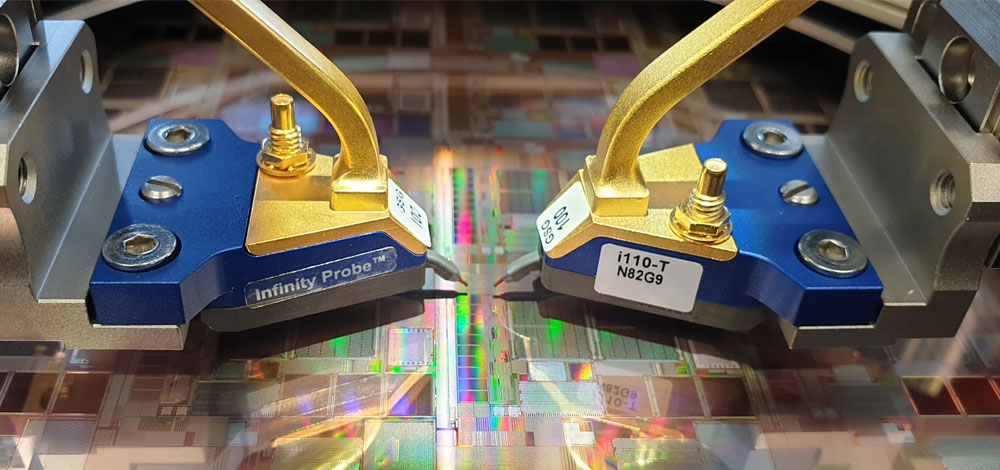At Fraunhofer IPMS the RF/mm-wave characterization can be done either in coaxial/waveguide measurement environment or at the wafer level. In either case, special measurement equipment as well as application-oriented setups are required. In particular, an advanced semi-automatic probe station allows automated on-wafer S-parameter characterization of 2-port devices up to 170 GHz and 4-port devices up to 67 GHz. On the other hand, the vector load-pull measurement setup up to 65 GHz and scalar load-pull measurement setup up to 110 GHz are available for nonlinear characterization of active devices. Furthermore, extraction of the noise parameters up to 170 GHz is performed by using the source-pull technique.
RF Characterization
Equipment
- Half-automated RF/mmWave probe station (300 mm, 12“)
- Vector Netzwerk Analysator (9kHz … 110GHz) with extension up to 170 GHz
- RF-Probes (GS/SG, GSG, GSGSG, 50 µm-100 µm pitch)
- Calibration standards
Radio frequency trade show expertise for 5G base stations of the future
RF characterization in the IPCEI project EMMA
The research project, called EMMA, includes seven work packages as well as a doctoral program to qualify young scientists in order to build long-term talent and promote the region's competitiveness. With a budget of more than 15 million euros, EMMA is the largest industrial project contract ever awarded to a Fraunhofer Institute by a company nationwide. Researchers at Fraunhofer IPMS are primarily working on new process developments for Globalfoundries' particularly power-saving FDX technology in the project. Other project parts focus on the development of non-volatile embedded memories as well as the characterization and modeling of high-frequency (RF) transistors.
In the RF project part, the Fraunhofer IPMS-CNT is responsible for evaluating new RF transistor concepts in FDX technology. This will identify particularly high performance RF chip designs that are critical for future 5G cellular deployment. Various test designs will be investigated for their functional performance and reliability over extended periods of time. In addition to extensive expertise and know-how, this requires highly sensitive measurement equipment. The most important measurement instrument here is an electrical prober, which can be used to contact and measure RF transistors directly on the wafer. In combination with Globalfoundries' FDX technology, the transistors achieve very good performance values with only extremely low parasitic influences. This allows higher output powers to be achieved in future 5G base stations without having to use more expensive compound semiconductor devices or integrate different devices on one chip. This enables more efficient, high-performance 5G chips that are easier to miniaturize compared to the alternatives.
Project EMMA
In 2018, the EU Commission approved a cooperation project for the microelectronics and user industries that is unique in Europe to date, an "Important Project of Common European Interest", or IPCEI for short. The project is being funded by the four participating countries Germany, France, Great Britain and Italy with a total of 1.75 billion euros. In the IPCEI, around 30 European industrial partners are working together in five technology fields during the project period 2017 - 2022. The largest partner among the 18 German companies involved is Globalfoundries Dresden. Fraunhofer IPMS is proud to be involved in this IPCEI as by far the largest research partner on behalf of Globalfoundries.
Publications
- W-Band Noise Characterization with Back-Gate Effects for Advanced 22nm FDSOI mm-Wave MOSFETs
- Assessment of a Thick-Oxide Transistor from the 22FDX® Platform for 5G NR sub-6 GHz FEMs
- DC-110 GHz Characterization of 22FDX® FDSOI Transistors for 5G Transmitter Front-End
- Analysis of Hot-Carrier Degradation in 22nm FDSOI Transistors Using RF Small-Signal Characteristics
 Fraunhofer Institute for Photonic Microsystems
Fraunhofer Institute for Photonic Microsystems